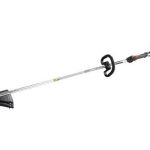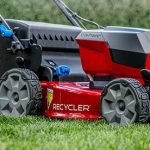As the calendar for 2018 rushes toward spring, you may be thinking about your lawn mower. After all, early spring means you’re back to cutting the lawn. Of course, you certainly want to be on top of things that concern lawn cutting so that you can jump right into it without any hesitation. So why you have a little time, consider this:
If you did not sharpen the lawn mower blade when preparing the mower to be put to bed for the winter, then it is something that you need to do when you prepare your mower for work. It is essential that all parts of a push lawn mower be properly maintained. Besides cleaning the carburetor and air filter when necessary, purging old gas from the lawnmower’s tank, cleaning the undercarriage, and periodically checking the fuel line, it is necessary to keep the blade sharp.

It is imperative that you keep your lawn mower blade sharp for best results in cutting the lawn. It also helps if you clean the old grass clips off of the blade and from underneath the deck.
(Courtesy: Phil Gwinn at flickr.com)
Outlets that sell lawn mowers and lawn mower parts should also have the capability to sharpen a blade. You can also do it yourself. Still, you will have to recognize that the blade needs sharpening. If the blade is too dull it rips at the grass rather than cuts it and this could make the grass susceptible to disease. A push mower blade can become dull for a number of reasons. They include:
- Wear and tear on the blade. As a push lawn mower is making its way through relatively tall grass the blade can often churn up some pebbles, dirt clumps, tree branches, and other small solid materials. These items can cause nicks, dings, and even curls in the blade.
- Infrequent sharpening. If you sharpen the blade frequently, then the task is easier to do the next time. That’s because you won’t have to grind as hard to achieve a sharp edge.
- Thinner blade vs. thicker blade. A thicker blade is more capable of resisting the dings, pings, and nicks than a thinner blade. So thinner blades will have to be sharpened more frequently.
- Cutting the grass too low. Lowering the carriage of the push lawn mower too much will result in shorter grass, but may also leave the blade more susceptible to the churned up stones and twigs.
- Too many clippings and debris on the underside of the carriage and a clogged discharge shoot after mowing. A dull, bent or loose blade can be the culprit and make it necessary to clean the undercarriage and discharge shoot more frequently.
Shops that sharpen a push mower blade commonly use a metal file if the blade is just dull. However, if the blade is more damaged, a bench grinder is used to sharpen it. The process results in the build up of heat and could weaken the steel of the blade. So when a lawnmower shop employee does this task, he frequently dunks the blade into a bucket of water during the procedure. He also dries it before continuing the grinding.
Although you can sharpen the blade yourself, it might be better to rely on a mower shop to do it. First, employees of the shop are trained in it and can better recognize if the blade needs to be replaced rather than just sharpened. In addition, it is imperative that the blade is properly balanced. If not, it can damage the mower. Mower shops are equipped with a plastic balancer and shop employees know how to use it to grind a bit of steel from the proper part of the blade to lighten it. If there is rust on the blade, then the shop employee will clean it off with steel wool or a steel brush. Using a bench grinder the process of sharpening takes less than 15 to 20 minutes. The blade should be what experts call “butter knife” sharp, not “razor” sharp. If the blade is too sharp, it could curl as pebbles and other hard materials hit it.
Save
Save
Save
Save
Save





